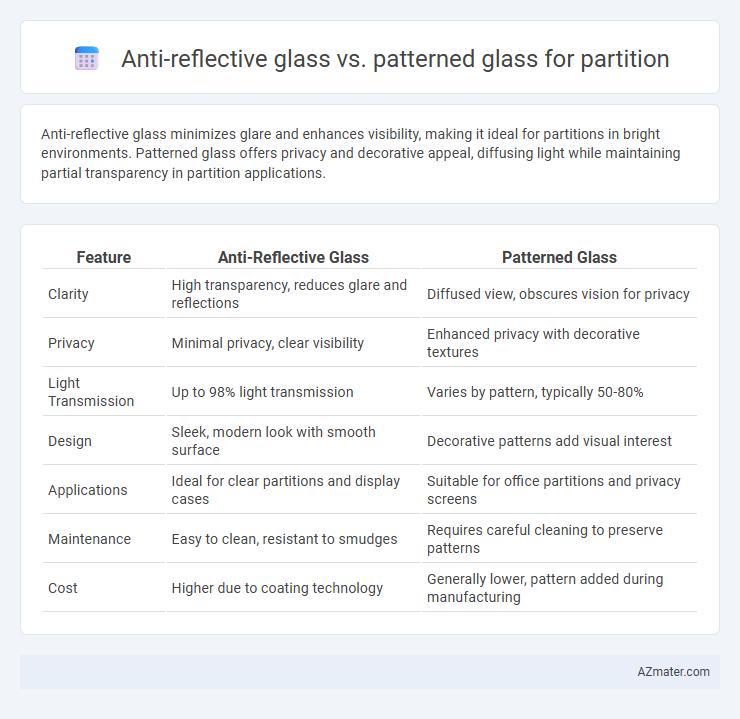Anti-reflective glass minimizes glare and enhances visibility, making it ideal for partitions in bright environments. Patterned glass offers privacy and decorative appeal, diffusing light while maintaining partial transparency in partition applications.
Table of Comparison
| Feature | Anti-Reflective Glass | Patterned Glass |
|---|---|---|
| Clarity | High transparency, reduces glare and reflections | Diffused view, obscures vision for privacy |
| Privacy | Minimal privacy, clear visibility | Enhanced privacy with decorative textures |
| Light Transmission | Up to 98% light transmission | Varies by pattern, typically 50-80% |
| Design | Sleek, modern look with smooth surface | Decorative patterns add visual interest |
| Applications | Ideal for clear partitions and display cases | Suitable for office partitions and privacy screens |
| Maintenance | Easy to clean, resistant to smudges | Requires careful cleaning to preserve patterns |
| Cost | Higher due to coating technology | Generally lower, pattern added during manufacturing |
Introduction to Glass Options for Partitions
Anti-reflective glass enhances visibility by reducing glare and reflections, making it ideal for modern office partitions where clarity and light transmission are essential. Patterned glass features textured surfaces that offer privacy while allowing natural light to filter through, often used in conference rooms or private workspaces. Selecting between anti-reflective and patterned glass depends on the balance needed between transparency and privacy in partition design.
What is Anti-Reflective Glass?
Anti-reflective glass is specially coated to minimize glare and reflections, enhancing transparency and visual clarity in partitions. This glass type improves light transmission by reducing surface reflections, making it ideal for office and commercial spaces where clear visibility is crucial. Compared to patterned glass, anti-reflective glass offers a sleek, unobstructed view while maintaining privacy through optional tinting or frosting treatments.
What is Patterned Glass?
Patterned glass features textured or embossed surfaces designed to enhance privacy while allowing light to pass through, making it ideal for partitions in offices or homes. Anti-reflective glass minimizes glare and reflections, providing clearer visibility and a sleek aesthetic but lacks the privacy benefits of patterned glass. Choosing patterned glass for partitions ensures both light diffusion and obscured views, enhancing functional separation without compromising natural illumination.
Visual Clarity: Anti-Reflective vs Patterned Glass
Anti-reflective glass offers superior visual clarity by minimizing glare and reflections, making it ideal for partitions where transparency and unobstructed views are essential. Patterned glass, on the other hand, diffuses light and obscures visibility due to its textured surface, providing privacy but reducing clarity. Choosing between the two depends on whether clear sightlines or enhanced privacy is the priority for the partition design.
Privacy Features: Which Glass is More Effective?
Anti-reflective glass minimizes glare and enhances visibility while offering moderate privacy by reducing reflections, making it suitable for spaces needing clear vision without distractions. Patterned glass provides superior privacy through its textured surface that obscures views while allowing natural light to pass, ideal for maintaining confidentiality in office partitions or meeting rooms. For maximum privacy, patterned glass outperforms anti-reflective glass by more effectively blocking visibility without compromising light transmission.
Light Transmission and Ambience
Anti-reflective glass offers high light transmission, reducing glare and enhancing natural illumination for a clear, bright ambience in partitions. Patterned glass diffuses light, creating privacy while softening brightness and adding visual texture, resulting in a subtle, cozy atmosphere. Choosing between the two depends on the desired balance between clarity and light diffusion for specific partition needs.
Durability and Maintenance
Anti-reflective glass offers superior durability due to its scratch-resistant coatings and reduced glare properties, making it easier to maintain and clean without compromising transparency. Patterned glass, while visually appealing with its textured surface, may require more frequent cleaning to avoid buildup in grooves and can be more susceptible to surface wear over time. Both options provide robust partition solutions, but anti-reflective glass stands out for lower maintenance needs and long-lasting clarity.
Cost Comparison: Anti-Reflective vs Patterned Glass
Anti-reflective glass typically costs 20-30% more than patterned glass due to advanced coating technology that reduces glare and enhances visibility. Patterned glass is generally more economical, offering a wide range of textures and designs at lower production expenses. Choosing between the two depends on budget constraints and the desired aesthetic or functional benefits for partitions.
Aesthetic Appeal and Design Flexibility
Anti-reflective glass enhances partition aesthetics by minimizing glare and reflections, creating a clear, unobstructed view that amplifies natural light and open space perception. Patterned glass offers diverse textures and designs, providing customizable privacy levels and artistic visual interest tailored to interior themes. Both options deliver distinct aesthetic appeal and design flexibility, with anti-reflective glass excelling in clarity and modern minimalism, while patterned glass adds texture and decorative complexity.
Choosing the Right Glass for Your Partition Needs
Anti-reflective glass for partitions minimizes glare and enhances visibility in office or home environments, improving productivity and aesthetics by reducing eye strain. Patterned glass offers privacy and decorative elements through various textures and designs, ideal for meeting rooms or private areas while allowing light diffusion. Selecting between anti-reflective and patterned glass depends on balancing transparency needs with privacy requirements and the desired ambiance in the partitioned space.

Infographic: Anti-reflective glass vs Patterned glass for Partition
 azmater.com
azmater.com